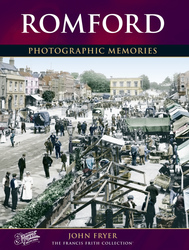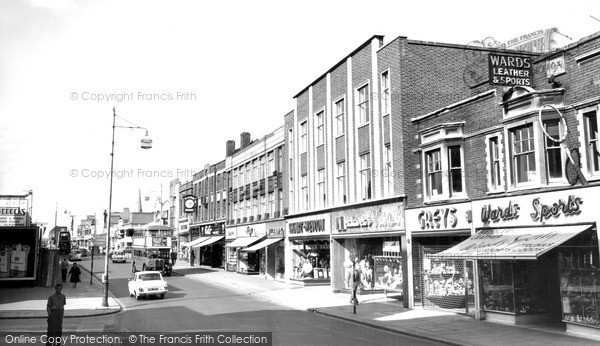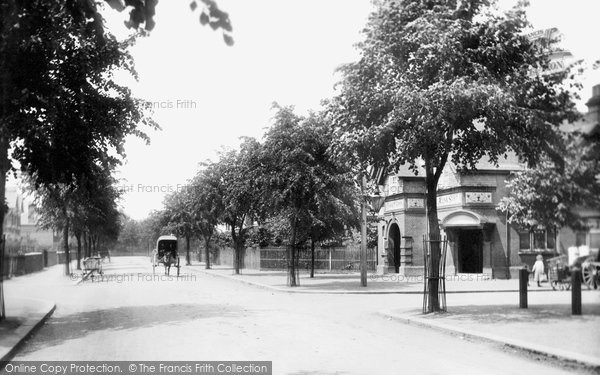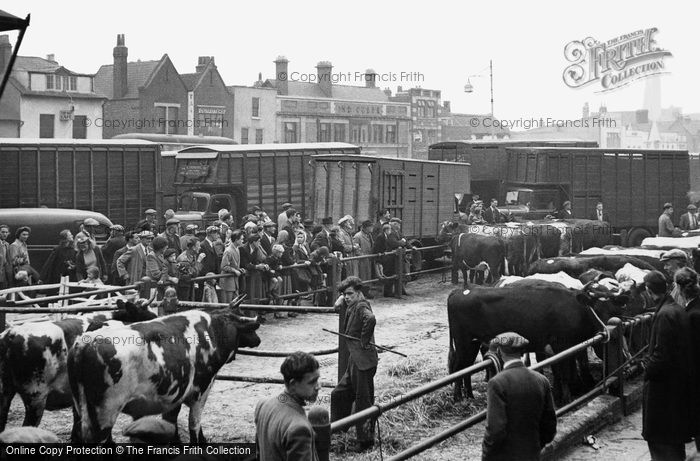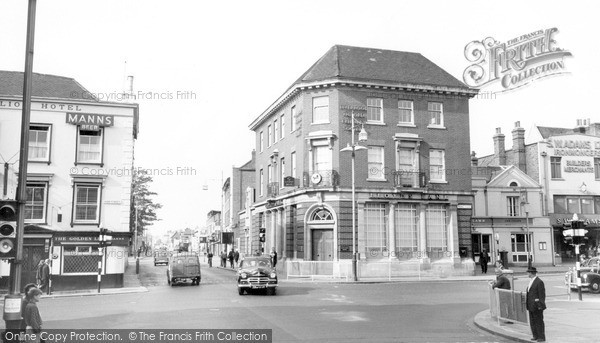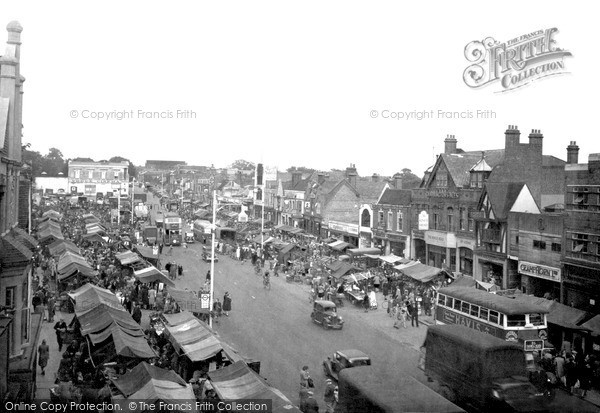Romford History
The history of Romford and specially selected photographs
Romford has changed dramatically over the last 30 years. The construction of ring roads and the pedestrianisation of South Street and other areas of the town centre, together with the building of huge shopping precincts and superstores, has all but erased the atmosphere of what was essentially a country market town. But the process of change began earlier in the 1920s and 1930s, and looking back further it is clear that Romford has a history of dramatic changes. This is not surprising because Romford is a 'thoroughfare town'. It has responded to the needs, and embraced the ideas, of generations of travellers who have passed by on the Essex Great Road from London to East Anglia and the coast.
Wherever there is a hazard or natural obstacle on a highway a town is likely to develop. The River Rom was an obstacle, originally a wide marshy river making its way down to the Thames. The word 'rom' is thought to come from a Saxon word meaning wide. Travellers would have welcomed a place to stay and the help of locals before they forded the Rom.
The ancient Trinobantes tribe lived in these parts, living off the land, using the marshes for protection and taking advantage of the forests which covered south east England for shelter, food and fuel. When the Romans came the Trinobantes joined the Iceni and, led by Boadicea, almost managed to drive the invaders from our shores. To protect their military road, which ran from their capital at Colchester to London, the Romans built an encampment in the Romford area. They called it Durolitum and to this day no one knows for sure where it was.
When the Romans left, the Saxon kings rapidly realised the importance of the area, with its forests alive with deer and wild boar and its marshland teeming with game. Edward the Confessor particularly favoured Havering and the rich sport it offered. The Normans arrived and organised the land, royal favourites being given valuable tracts of land to administer and develop as feudal estates.
In Plantagenet times Henry III granted a charter to permit a livestock market to be held in Romford. This was in 1247 and it assured the town's future. In no time it became a centre for all kinds of trade and a place where people of influence met. As the town grew, merchants and professional people came to live here, businesses were set up, institutions established and a civic identity began to develop.
Edward IV recognised the growing stature of the town in 1465 when he granted the Charter of the Liberty of Havering-atte-Bower with Romford as its capital. This gave the inhabitants of the Liberty, which stretched from Havering in the north to the Thames in the south, a remarkable degree of independence. Wrongdoers could only be tried before a court set up by the people of the Liberty regardless of their alleged crime, the only exception being treason. All conditions of trading, standards and quality of goods and commercial agreements were determined by the Liberty's elected officers. The Liberty's independence from the County of Essex remained until it was abolished on 9 May 1892.
From the 15th century onwards, magnificent country houses with extensive estates dominated the countryside around Romford. In 1450 Thomas Cooke, a prosperous London merchant, held Gidea Hall, Bedfords, East House (to the west of North Street), and Redden Court. Cooke was made Lord Mayor of London in 1462. Marks House, from which we get Marks Gate, west of Collier Row, was held by Thomas Urswick, Recorder of London, who in 1471 was knighted by Edward IV on the field of battle. Brettons at South Hornchurch was the home of William Ayloffe who was Justice of the Peace for Essex and Suffolk. The Romford poet Francis Quarles was born in 1592 and achieved high office only to lose his land and possessions when he used poetry to criticise the Parliamentarians.
In 1599 the actor William Kemp danced the morris from London to Norwich. Although his journey took about a month he only danced on nine days thus adding the term 'nine-day wonder' to the English language. He rested in Romford for two nights. Another visitor to the town was Colonel Blood, famous for stealing the Crown Jewels from the Tower of London in 1671. He moved to Romford three years earlier and planned his daring crime in a house in the Market Place close to where the Shopping Hall is today. When the jewels were returned Charles II gave Blood a pardon, a pension and an estate in Ireland.
In 1799 Edward Ind bought the Star Inn which had a reputation for brewing exceptionally fine ale. He developed a successful brewery and began selling the ale over a wide area. In 1845 Octavius and Edward Coope joined the business and, as they say, the rest is history. Sadly that part of Romford's history came to an end in 1993 when production ceased at the Romford Brewery. Now the new Sainsbury's Hypermarket complex stands on the site.
In 1838 the railway reached Romford from London and the era of mechanised transport had begun. Soon the town's wonderful old inns would no longer echo to the sounds of excitement as the frequent stagecoaches arrived and departed on their way to East Anglia and the coast.
We have all heard the old Scottish song about Annie Laurie, but one of her relatives, John Laurie, came to live at Marshalls to the east of North Street in the 1840s. He had a vision of creating the first 'garden city' and planned to build it in Romford. He laid out Laurie Square and built the Laurie Hall which was to be the town's court house. He built St Edward's Hall on the east side of the square and four fine town houses to the north, but he was unable to buy further land and the 'Laurie Town' project was abandoned. Laurie Hall was never used as a court house but was put to several uses including a mission, a cinema and a humble store for market stalls. The St Edward's Way, Mercury Gardens roundabout and pedestrian underpass, and the central library stand where John Laurie's dream came to an end.
Herbert Raphael's plans for a Gidea Park Garden Suburb were much more successful. He bought the Gidea Hall estate in 1897. Already the estate leased 90 acres of its eastern extreme to the Romford Golf Club of which Raphael was a founder member. On the town centre extreme of the estate was Black's Canal and although this sounds as if it should pass between dark satanic mills, it was in fact a beautiful ornamental lake complete with an elegant bridge carrying the main road from Romford to Hare Street. Raphael gave the lake and 15 acres of park and woodland to the people of Romford who enjoy the delights of Raphael Park to this day. He now had a secluded site between the park and the golf course on which to develop his exclusive garden suburb with its landscaped roads and architect-designed residences. In 1900 Romford proudly opened its public indoor swimming baths in Mawney Road; they were demolished in 1975.
Between the World Wars Romford developed at an astonishing pace. People moving into the new residential estates knew that there was plentiful employment both in the town and close by. Romford had become a commuter town with frequent trains to London from Gidea Park and Romford, and from Upminster, Hornchurch and Elm Park. There was also a profusion of frequent bus routes linking residential areas with places of work and shopping centres. In the town Roneo, Romford Brewery, Betterware and a variety of light industries provided employment and close by in Dagenham was The Ford Motor Company, Briggs Motor Bodies and a range of factories and works in a corridor along the north bank of the Thames. While looking at developments in the town it is easy to overlook the farms, smallholdings and nurseries in the countryside around Romford. Sometimes town and country clashed and it is said that from time to time a 'cowboy' on horseback was called in by The Ford Motor Company to round up cattle which had strayed in from the grazing marshes onto the assembly lines.
As the population of Romford grew and had a little more money in its pockets, consumerism struck the town with a vengeance. The greatest impact was in South Street which became dubbed 'The Golden Mile'. It was said that if a retailer acquired a shop in South Street his fortune was assured. In the widened thoroughfare many old-established local traders were replaced by national chain stores. In 1935 the Quadrant Arcade was opened providing almost 40 shop units of various sizes in an L-shaped layout between the Market Place and South Street. Romford had three arcades, the Quadrant with its 'glitzy' Odeon style, the Romford Shopping Hall in the Market Place which was more down to earth, and the arcade in South Street which was often referred to as Craddock's arcade with Craddock's the stationers and toy shop and other well-remembered shops: Wings Bookshop and Well's Music Stores.
A favourite store was Stones in the Market Place. Denny Stone founded the store in 1864 and from small beginnings acquired adjacent shops until, in 1939, a large modern store was built. It was replaced by an even larger store in 1963, by which time Stones had merged with Debenham's. In 1937 Romford achieved Borough status, the Lord Mayor of London, Sir George Broadbridge coming to the town to present the Royal Charter. The ceremony took place in the new Town Hall, a building of considerable architectural merit. The first mayor was Charles H Allen.
After the Second World War the pre-war bustle and energy of the town returned quite quickly. On market days traffic and people were soon happily mingling in the Market Place, the pavements of South Street were soon crowded with jostling shoppers, and everywhere there were buses. I remember counting 14 buses on the 175 queuing nose-to-tail to set passengers off at the stop by Branden's in South Street.
But the world was changing, people were changing, we wanted our own transport, our shopping habits were changing. Not for the first time in its history Romford needed to evolve. To many of us who loved the old Romford, even though it was at times a little scruffy and smelly, the development of the town centre which started in the 1960s spelt the end of an era. Perhaps the changes were necessary for the town to compete with neighbours and out-of-town shopping complexes, perhaps the new pedestrian precincts were safer and more comfortable, but somehow the robust chaotic character of the old town had been lost. Maybe in time the new Romford will develop a character just as strong as the old.
Fortunately many of the towns and villages in the Borough have retained some of their individual identities. In spite of being administratively lost in the London Borough of Havering, Havering-atte-Bower still has its charm and Hornchurch and Elm Park have an atmosphere of their own. Upminster and Corbets Tey are still countryfied and Gidea Park is much as Herbert Raphael intended it to be.
A thoroughfare town, Romford has for centuries watched travellers pass by, each leaving their mark on the town. Everyone who has ever lived in the town has contributed to it in their own way. So close to London, yet so close to the Essex countryside, Romford has been endowed with a rich and varied history, both early and more recent. This book celebrates in pictures Romford's diverse and fascinating past and wanders nostalgically out to its surrounding towns, villages and hamlets.
Further Reading
To discover the histories of other local UK places, visit our Frith History homepage.
Romford History in Photos
More Romford PhotosMore Romford history
What you are reading here about Romford are excerpts from our book Romford Photographic Memories by John Fryer, just one of our Photographic Memories books.
